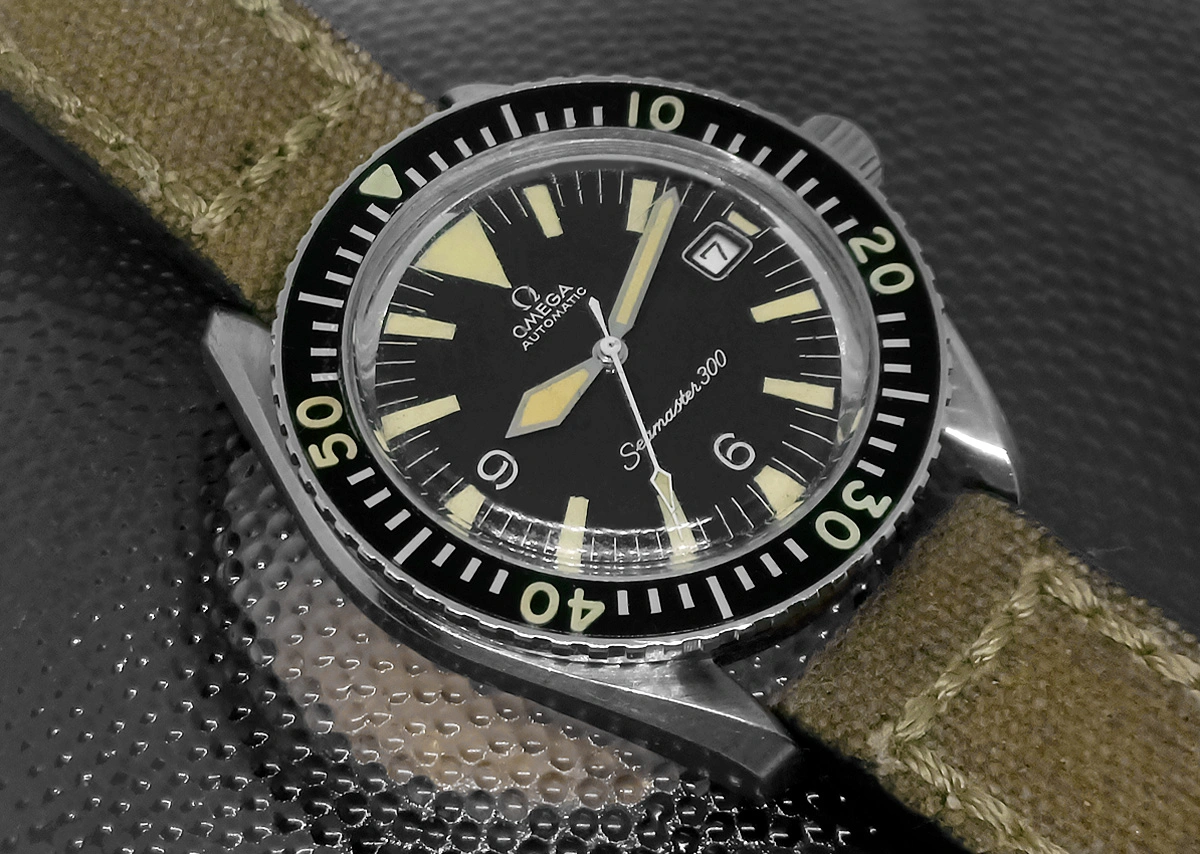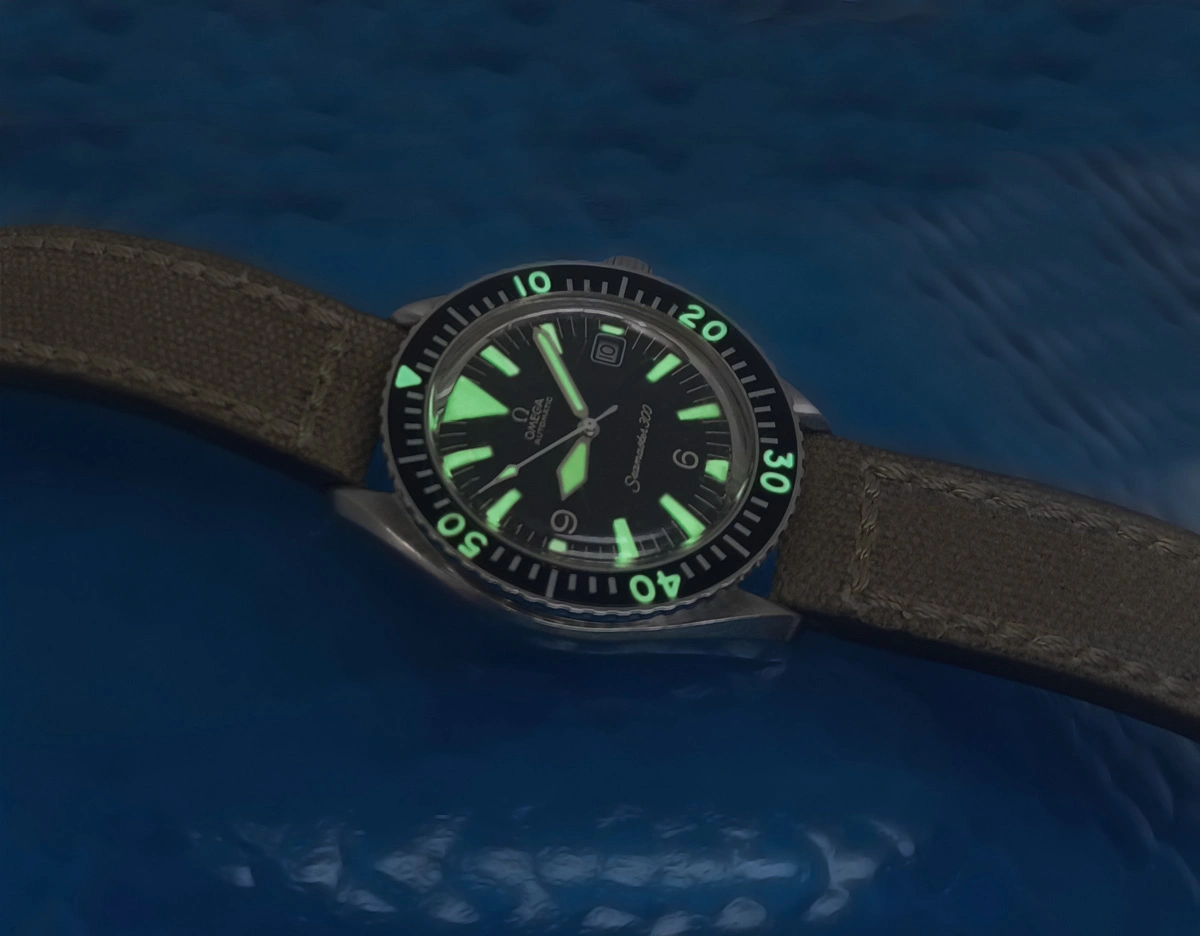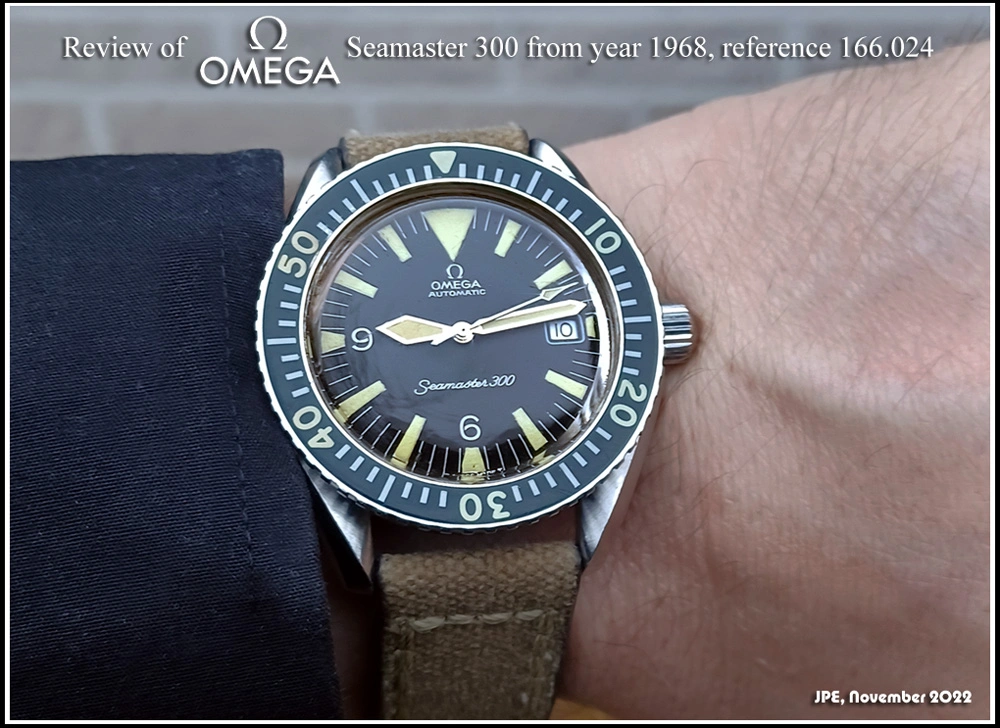
Again, I’m not trying to reinvent the wheel and write a technical analysis about this watch – nor a comprehensive guide, because it’s all already been done in many excellent summaries by other people. Here is the best I’ve found.
Vintage Seamaster 300 review by Jack Norman
In my own blog, I have focused more on the aesthetic side of watches, tried to take good photographs and have written texts more on a feeling basis.
Photographing and reviewing this watch also finishes my “Omega Week” with three spectacular vintage examples that were lent to me by Watch Service Finland.
You can read the two other articles from the following links:
Review of Omega Seamaster PloProf 600
Review of Omega Seamaster PloProf 1000
The Omega Seamaster 300, manufactured between 1962 and 1969, is one of the models that has significant collectible value among collectors. And the values have raised every year.
The main reasons are the design and size. Ironically, the watches of the 60’s/70’s were mostly quite small. Even as small as 34 millimeters, which by today’s modern standards is closer to the size category of a ladies watch. Those small vintage Omega dress models have a lot of fans but very few of them have any significant value. Of course this is not something that’s carved in stone (as many small sized vintage watches can be valuable too) but it’s more like a general rule of thumb.
The Seamaster 300 is different. It is 42 mm, which is remotely big watch, even by today’s standards. In addition to that, its design language is successful in every way.
Round case, thick hands and large, glowing luminous hour markers. Likewise, the numbers on the bezel are luminous, as in the PloProf collection.
The early examples came with radium dials but radium was quickly banned by the Swiss watch industry because it was considered radioactive. The dial has T SWISS T markings on the 6’o’clock which refers to tritium. The glow on this watch is so strong that I thought the material had to be luminova from a Omega service dial. But no, it’s the original tritium dial which was verified by the owner.
How can the original tritium dial glow so strong after 50+ years? I got interested in this subject and “Sinnlover” from TZ.com explained it so well.
Tritium is the agitator, this makes the material it is contained in glow. Tritium’s half life means the amount of radiation in the dial paint will be very limited now but it will still be present.
Dependant on what the lume material is made of, UV light can make it glow for a short while. I have a Tutima NATO Chrono that is still quite bright just after shutting off the lights and it glows for a good 20 mins or so after. My Snowflake Sub is totally dead though.
“The level of radioactivity present in tritium halves every 12.5 years, when the level of radioactivity drops enough it will no longer agitate the luminous compounds in the paint. UV exposure will cause the lume to glow for a limited time after the radioactivity levels drop below the level required but it’s not tritium that is causing the glow.
The paint might glow but it is not glowing in the manner intended.
Surface area and thickness of the application can also influence the perceived lume brightness just as with Luminova.
The Big Triangle has large hands and plots with thick paint, this will mean bright lume. Compare this with a Submariner of the same age. The SM will seem much brighter.”
Why is a woman beautiful or why is a watch beautiful? After all, there are no definite units or measurements that can be used to define such completely subjective things. “Beauty is in the eye of the beholder” is such a creepy and tired cliché, but it’s true.
However, there are women and watches that are generally considered beautiful and the Omega Seamaster 300 is certainly one of those watches. How could you not like it?

The very first models came without a date, and even though 1962 is officially marked as the start of production, the first watches did not arrive at the dealers until 1964. The date version did not enter the production until 1964, and the watch was available with both a leather strap and a bracelet. Most of the watches on the market have a leather strap, and the market price of the original SM300 steel bracelet alone is measured in four figures.

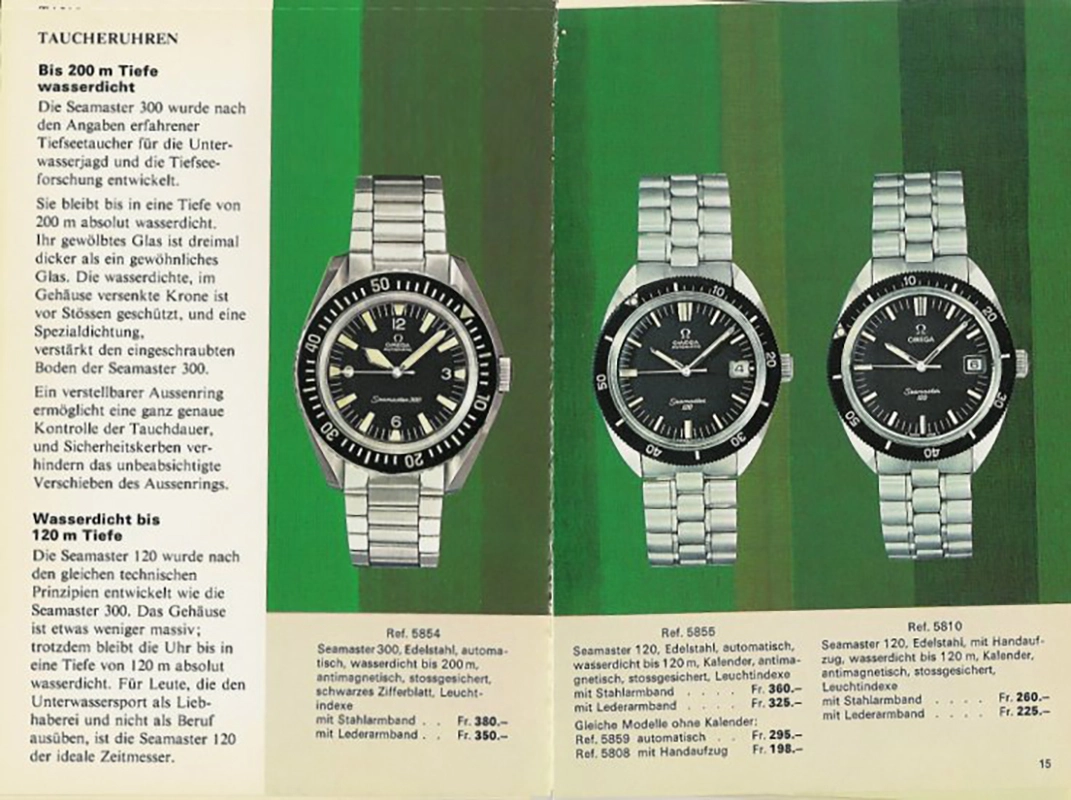
The glass is hesalite glass, i.e. acrylic, i.e. practically transparent plastic. It was a very typical choice for diver’s watches of this era. Rolex also used similar glass in their older models. The Sea-Dweller 16660 was the first sports Rolex to have a sapphire crystal in 1978, and the Submariner got it in the 16800 model in 1979. However, the first sapphire crystal was seen on the OysterQuartz already in 1970.
Acrylic crystals scratch easily, but they’re very good at absorbing shocks. They’re also easy to polish yourself and replacing them is usually quite inexpensive. Vintage watch enthusiasts do not care about wear and scratches. On the contrary, an often unpolished, original watch is more desirable and valuable. Of course, this is the opposite of, for example, classic cars, where an individual restored example always commands the premium.
I’m personally very attracted to some moderate patina, wear and tear on vintage sports watches. These are originally designed for hard use.
This particular watch has the “Big Triangle” dial which refers to the 12’o’clock hour marker (self-explanatory). This dial version was introduced in 1967. Typically this dial came with the “sword hands” which is the case with this particular example too. The bezel (with luminous numbers) has 60 clicks and it’s bi-directional.
You would think it’s waterproof to 300 meters as the model name indicates, but no. It’s officially waterproof to 200 meters or 660ft. I have no idea what’s the history behind that. Maybe it was originally intended to have 300m rating? The model name is one of the quirky things of this watch.
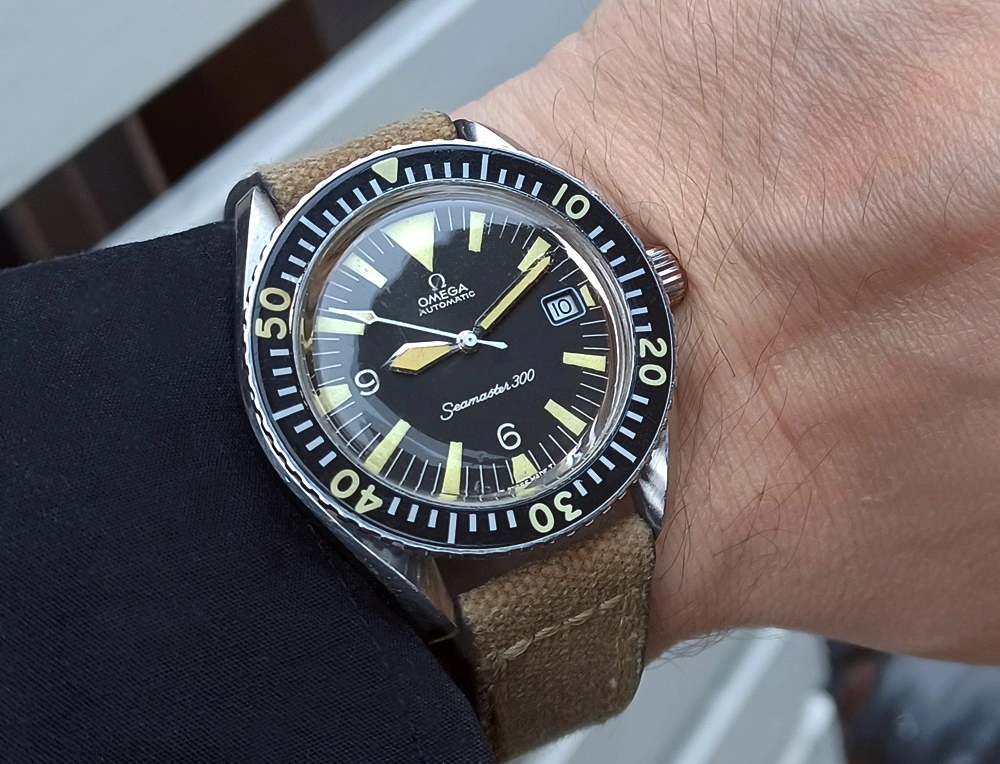
The vintage watch market has been hot in recent years, and it has also brought with it some unpleasant phenomena. For the Seamaster 300, perhaps the most famous incident was the so-called “The WatchCo Scandal”.
WatchCo is an Australian watch company that had an official Omega service certificate.
This meant they also had access to original Omega spare parts. When prices of the Seamaster 300 started to rise, WatchCo ordered as many SM300 parts as they could. After this they started manufacturing “genuine frankenwatches”. That is, they assembled “new old” Seamasters from genuine spare parts. They did not lie to the customers and sold the watches with the exact technical descriptions as they were.
However, this angered Omega and they stopped supplying parts to dealers and stripped the Omega service licence from WatchCo. This policy also affected Otto Frei and several other large retailers.
Perhaps “frankenwatch” is not the correct term for WatchCo’s SM300’s, as the parts used were original. They weren’t fake either. So what were they? Maybe just new unofficial retro versions?
Many watch enthusiasts were not bothered by this and are happy to pay less for a classic model that has been “restored” to new condition. Here is an example of a “WatchCo” Seamaster 300 for sale at Watch Co. The asking price is £5,600, which is significantly less than the original model in decent condition.
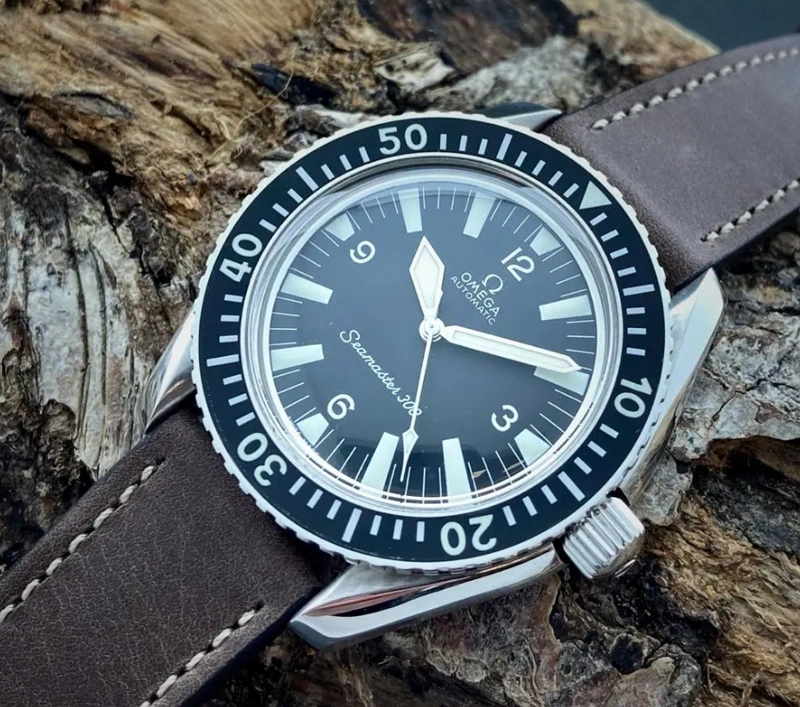
The SM300 is perhaps the finest and most desirable Omega I’ve had the chance to try. I owned both the 42mm and 45mm versions of the Planet Ocean and I think the PO is one of the few “new” models that impressed me. It implemented so much of the original Seamaster 300 details to its design. That can’t be a bad thing.
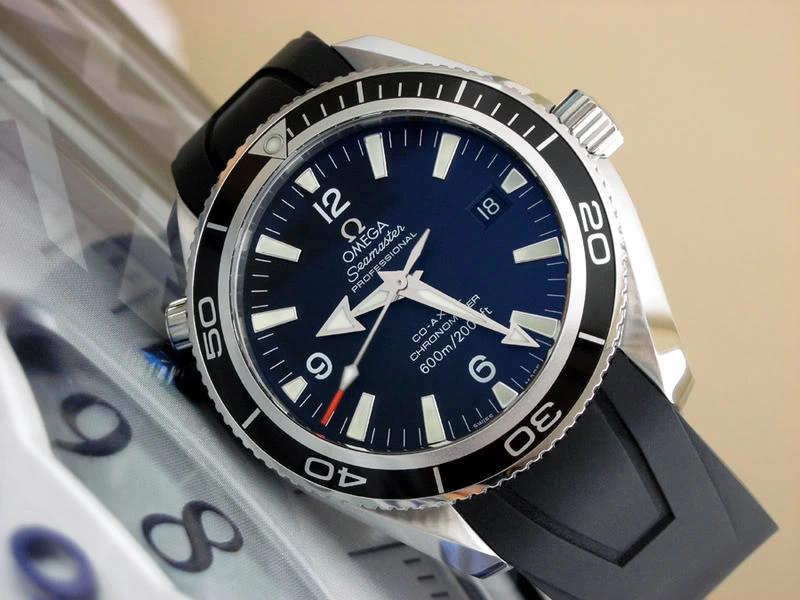
Omega also released the “retro version” of the SM300 in Baselworld 2017. They released the full 1957 Trilogy (Speedmaster CK2915, Seamaster 300 CK2913, Railmaster CK2914) to celebrate the brand’s 60th anniversary.
The retro version of SM300 has been very popular, and rightfully so. It was tastefully done. Personally, I’m not quite sure what I think about these “restomods”. They’re a mixed bag in the classic car community too. But of course, when the factory itself releases it, it’s a bit different. Like I said, the retro version is very nice but I would still personally go for the original.
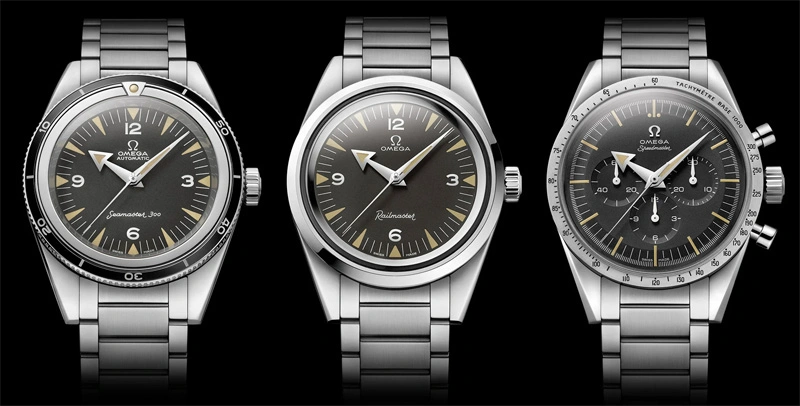
The leather strap fits the SM300 very well, but I would definitely prefer the watch with a steel bracelet. The SM300 compares very well to perhaps the most famous diver’s watch of them all, the Rolex Submariner. They feel very similar on the wrist and although the design is quite different, the wrist presence certainly has some similarities.
Review of ROLEX Submariner 16610
Omega, as a brand, has been releasing way too many “special editions” and cheesy “James Bond limited editions” lately. I never understood why would anyone over 12 years old would want to have a “007” stamped on their watch dial.
But this watch is an example what they should be doing. Keep the lineup basic and simple – and keep the watch designs basic and simple too. Planet Ocean was a hit. But was it a hit because it had so much resemblance to the SM300?
I haven’t bought a lot of watches in the recent decade. There just aren’t many watches I still want. And even the ones that I really want, are all in the vintage market and prices have gone insane. A friend offered me a Rolex 1675 for 5000 dollars back in 2008. I was stupid enough to refuse and bought a 16710 instead. I should have bought them both.
My review of Rolex GMT Master II 16710
Now unmolested, original 1675/16750’s are starting from 13.000$. I’m not complaining, that’s just capitalism but I’m not playing in that market. Same for SM300. They’re becoming too expensive.
But still… besides the Rolex 1675, this is one of the very few watches left that I’d like to have in my collection. Omega hit the nail on the head with this design. It’s perfectly sized (looks great on a bigger wrist too), the design is pretty much the best Omega has ever done and absolutely everything “clicked” with this model. It’s hard to believe it was designed in the early sixties because the design is so contemporary.
Thanks again to Watch Service Finland for having me the opportunity to review and photograph this legendary watch.
Thanks for reading and feel free to comment below.
